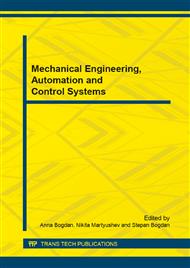[1]
G. Sutter, N. Ranc, Temperature fields in a chip during high-speed orthogonal cutting - An experimental investigation, Int. J. of Machine Tools and Manufacture 47(10) (2007) 1507–1517. C.
DOI: 10.1016/j.ijmachtools.2006.11.012
Google Scholar
[2]
C.E. Campbell, L.A. Bendersky, W.J. Boettinger, R. Ivester, Microstructural characterization of Al-7075-T651 chips and work pieces produced by high-speed machining, Materials Science and Engineering A 430(1-2) (2006) 15–26.
DOI: 10.1016/j.msea.2006.04.122
Google Scholar
[3]
H. Miguelez, R. Zaera, A. Rusinek, A. Moufki, Molinari A., Numerical modelling of orthogonal cutting: Influence of cutting conditions and separation criterion, J. de Physique IV 134 (2006) 417-422.
DOI: 10.1051/jp4:2006134064
Google Scholar
[4]
Hortig, B. Svendsen, Simulation of chip formation during high-speed cutting, J. of Materials Processing Technology 186(1-3) (2007) 66–76.
DOI: 10.1016/j.jmatprotec.2006.12.018
Google Scholar
[5]
J.P. Davim, C. Maranhao, A study of plastic strain and plastic strain rate in machining of steel AISI 1045 using FEM analysis, Materials and Design 30(1) (2009) 160-165.
DOI: 10.1016/j.matdes.2008.04.029
Google Scholar
[6]
J. Shinozuka, Experimental investigation on the cutting mechanism of oxygen free copper in cutting speeds ranging from 1 m/s to 210 m/s, Advanced Materials Research 797 (2013) 208-213.
DOI: 10.4028/www.scientific.net/amr.797.208
Google Scholar
[7]
J. Shinozuka, H. Yachi, T. Higashi, M. Sando, T. Maetani, S. Unami, Y. Ozaki, Effect of MnS on the cutting mechanism of powder metallurgy steel in cutting speeds ranging from 1 m/s to 150 m/s, Advanced Materials Research 565 (2012) 370-375.
DOI: 10.4028/www.scientific.net/amr.565.370
Google Scholar
[8]
J. Shinozuka, M. Sando, T. Horie, Ultra high-speed cutting experiment under the cutting condition that cutting speed exceeds plastic wave speed of workpiece, Advanced Materials Research 325 (2011) 327-332.
DOI: 10.4028/www.scientific.net/amr.325.327
Google Scholar
[9]
S.A. Zelepugin, A.S. Zelepugin, Modeling of the destruction of targets during a high-velocity impact, Russian Journal of Physical Chemistry B 2(2) (2008) 246-250.
DOI: 10.1134/s1990793108020127
Google Scholar
[10]
G.I. Kanel, V.E. Fortov, S.V. Razorenov, Shock waves in condensed-state physics, Physics-Uspekhi 50(8) (2007) 771-791.
DOI: 10.1070/pu2007v050n08abeh006327
Google Scholar
[11]
V.A. Gorelski, S.A. Zelepugin, A. Yu. Smolin, Effect of discretization in calculating three-dimensional problems of high-velocity impact by the finite-element method, Computational Mathematics and Mathematical Physics 37(6) (1997) 722-730.
Google Scholar


